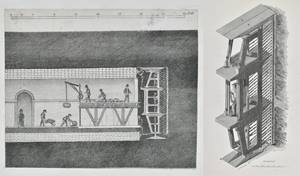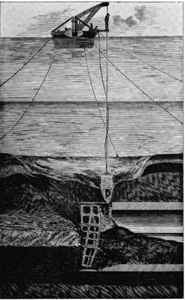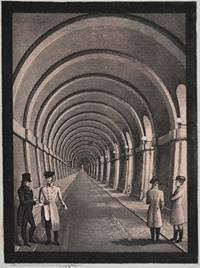
|
Detail of the unfinished tunnel from:Thames Tunnel Company, ‘An explanation of the works of the tunnel under the Thames from Rotherhithe to Wapping’, London: W. Warrington (1838)
|
The image above is a detail from one of the Geological Society's rare books - Thames Tunnel Company, ‘An explanation of the works of the tunnel under the Thames from Rotherhithe to Wapping’, London: W. Warrington (1838). The commemorative volume celebrates the construction of the Brunels’ tunnel under the Thames which connected Rotherhithe to Wapping. Curiously it was issued in 1838 when the tunnel was still incomplete. It would not open until 1843.

|
|
Plan Shewing the progress of the Thames Tunnel, 1838, from: Thames Tunnel Company, ‘An explanation of the works of the tunnel under the Thames from Rotherhithe to Wapping’, London: W. Warrington (1838).
|
The idea of a tunnel between Rotherhithe and Wapping was suggested by Marc Brunel (1769-1849) in 1824. It was not, however the first or even second attempt to build a tunnel under the Thames. In fact it was the third. The first tunnel was proposed in 1798 by the engineer Ralph Dodd (c.1756-1822). Unlike the following two tunnels, which were driven by the need for constructing a more direct passage across the river for the movement of freight from the London dockyards, it was to benefit the military. Dodd’s tunnel was to run between Gravesend to Tilbury (near Tilbury Fort) and work began on sinking the first shaft in 1800. By the end of 1802, despite the shaft being lined and a steam engine installed, water still flooded into the works and the plan was abandoned.
In 1802 a Cornish mining engineer Robert Vazie (b.1758) proposed constructing a tunnel between Rotherhithe and Limehouse, near the existing Horseferry route. The Thames Archway Company was formed in 1805 to undertake the project. A full sized tunnel was never constructed; instead work began on a pilot tunnel or driftway which was to act as a drain for the larger pedestrian ‘archway’ that was to be built underneath.

|
Plan and section from Thames Archway Company, 'Progress and State of the Tunnel under the Thames', March 1809 , the prospectus calling for alternative solutions for the tunnel's completion. (Archive ref: LDGSL/441). Click to enlarge.
|
By 1807, Vazie had been fired and replaced by another Cornish engineer Richard Trevithick (1771-1833) and his team of Cornish miners. Fighting through multiple ingresses of water they managed to reach within 117 feet of the north side of the Thames. However, the instability of the riverbed led Trevithick to suggest to the directors of the Thames Archway Company a novel idea of excavating the rest of the driftway from above. The directors, being less than enthused by this untested plan, instead issued a prospectus calling for alternative schemes in March 1809. Forty-nine proposals were received, but none were apparently credible so the tunnel was abandoned.
The Brunel Tunnel

|
|
Brunel’s tunnelling shield in action, from Thames Tunnel Company, ‘An explanation of the works of the tunnel under the Thames from Rotherhithe to Wapping’, London: W. Warrington (1838). Click to enlarge
|
The location of the Brunels’ tunnel less than a mile from Vazie’s and Trevithick’s driftway indicated the economic importance of a direct route across the river in the Docklands area. Whilst pedestrian traffic could use the services of the Thames Watermen to take them directly across, larger freight had to take a three mile round trip to cross by London Bridge. The attractiveness of a tunnel as opposed to constructing a new bridge was that you didn’t have to allow for the height of the masts of shipping vessels to get through.
A Parliamentary Bill for the Thames Tunnel Company for ‘Making and Maintaining a tunnel under the Thames’ was given Royal Assent in 1824, with work on the shaft at Rotherhithe beginning in March 1825. The difference between the previous two tunnels was Marc Brunel’s patented tunnelling shield. The shield was to provide support to the mining operation whilst the tunnel was encased securely in brickwork. It comprised a series of fixed and adjustable frames that inched forward at a rate of initially around eight feet per week as the tunnelling progressed.
In the spring of 1827, the first major flood stopped work.
A Visit from the Geological Society
In May 1827, four of the Geological Society’s Fellows were keen to inspect the tunnel in person. William Buckland (1784-1856) and George Featherstonehaugh (1780-1866), then Roderick Murchison (1792-1871) and Charles Bonaparte (1803-1857) took it in turns to go down in pairs in a diving bell. Murchison later recorded an account of the experience in his biographical journal in the 1860s:

|
| An image of the diving bell which was sunk to inspect the damage in 1827, reproduced in The Project Gutenberg eBook of Tunnel Engineering—A Museum Treatment, by Robert M. Vogel. Fig 24 |
"The first operation we underwent (one which I never repeated) was to go down in a Diving Bell upon the cavity by which the Thames had broken in. Buckland and Fetherstonhaugh having been the first to volunteer came up with such red faces & such staring eyes that I confess I felt no great inclination to follow their example particularly as Charles Bonaparte was most anxious to avoid the dilemma - excusing himself by saying that his family was very short necked & subject to apoplexy etc. But it would not do to show the white feather I get in & inclined him to follow me. The effect was as I expected most oppressive & then on the bottom what did we see but dirty gravel & mud for which I brought up a fragment of one of Hunts blacking bottles! We soon pulled the string & were delighted to breathe the fresh air.”
The men were then taken in a punt through the flooded tunnel by Marc Brunel’s 21 year old son Isambard (1806-1859), who had joined as resident engineer the previous year.
“The first folly was however entirely overpowered by the next. We went down the shaft on the south bank & got with young Brunel into a punt, which he was to steer into the tunnel till we reached the repaving shield under repair. About 11 feet of water was still in the tunnel, leaving just space enough above our heads for Brunel to stand up & claw the ceiling & sides to impel us. As we were proceeding he called out "Now Gentlemen if by incident there should be a rush of water I shall turn the punt over to prevent you being jammed against the roof & we shall then be carried out and up the shaft!" On this C[harles] Bonaparte remarked "sir I cannot swim" & just as he had said the words Brunel swinging carelessly r[ight] to l[eft] fell overboard & out went of course the candle with which he was lighting up the [tunnel]
Taking this for the 'sauve qui peut' [everyman for himself] fat C[harles] Bonaparte the very image of Napoleon at St Helena was about to roll out after him when I held him fast & by the glimmering light from the entrance we found young Brunel [?he’d] swam like a fish coming up on the other side of the punt & we soon got him on board. We did of course call out for an immediate retreat for really there could not be a more fool hardy & ridiculous risk of our lives inasmuch as it was just the moment of luck as to whether the Thames would make a further inroad or not.” [Roderick Murchison's biographical journals, [1860s] LDGSL/941/7]

|
The interior of the incomplete tunnel. Marc Brunel is pictured on the far left, Isambard is on the far right. From Thames Tunnel Company, ‘An explanation of the works of the tunnel under the Thames from Rotherhithe to Wapping’, London: W. Warrington (1838)
|
Work restarted in the winter of 1827 and by the time the commemorative volume was published in 1838 the tunnel had flooded a further four times. In November 1841 the tunnelling reached Wapping. The tunnel was finally open in 1843.
The tunnel was intended for pedestrian and coach traffic but in 1865 it was sold to the East London Railway to be turned into a railway tunnel. It still exists, now forming part of the London Overground line.
Bibliography
Contemporary sources:
First tunnel
“Learned Societies Intelligence – Engineering”, Philosophical Magazine, vol 1 (1898) , pp223-4. [Ralph Dodd’s Tilbury-Gravesend tunnel]
Second tunnel
Farey, John, “On the stratification of England; the intended Thames Archways, &c”, Philosophical Magazine, vol 25 (1806), pp44-49
Farey, John, “On the intended Thames Archway between Rotherhithe and Limehouse ”, Philosophical Magazine, vol 33 (1809), pp372-383
Horner, Leonard, coloured drawing of a section of the strata of the Rotherhithe to Limehouse Tunnel, with notes, analysing the geology of the intended course of the tunnel below the Thames which was being constructed by the Thames Archway Company, [1808]. Archive ref: LDGSL/442
Thames Archway Company, 'Progress and State of the Tunnel under the Thames', March 1809. Tract series- QP Misc 63. Engraved plan and section at LDGSL/441.
Third tunnel
Murchison, Roderick Impey. Account of descending into the Thames Tunnel in 1827, Biographical Journals, Archive ref: LDGSL/841/7
“Thames Tunnel”, Mining Review. A monthly record of geology, mineralogy and metallurgy, 31 July 1839.
Thames Tunnel Company (1838) An explanation of the works of the tunnel under the Thames from Rotherhithe to Wapping. London: W. Warrington
Modern sources:
Mathewson, A, et al, The Brunel’s Tunnel. London: Brunel Museum (2006)
West, Graham, Innovation and the rise of the tunnelling industry. Cambridge: Cambridge University Press (1988)
The Project Gutenberg eBook of Tunnel Engineering. A Museum Treatment, by Robert M. Vogel (accessed November 2021) https://www.gutenberg.org/files/39785/39785-h/39785-h.htm